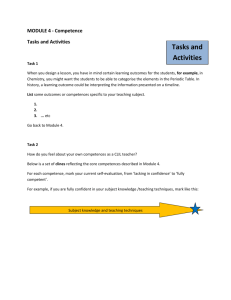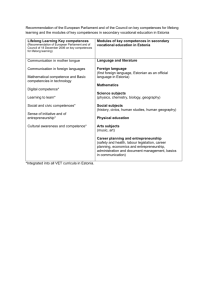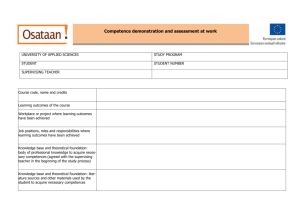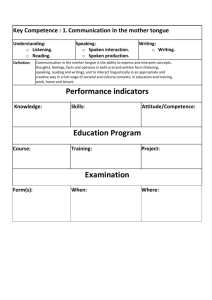TREATMENT OF KEY COMPETENCES IN THE LOOK & THINK
advertisement
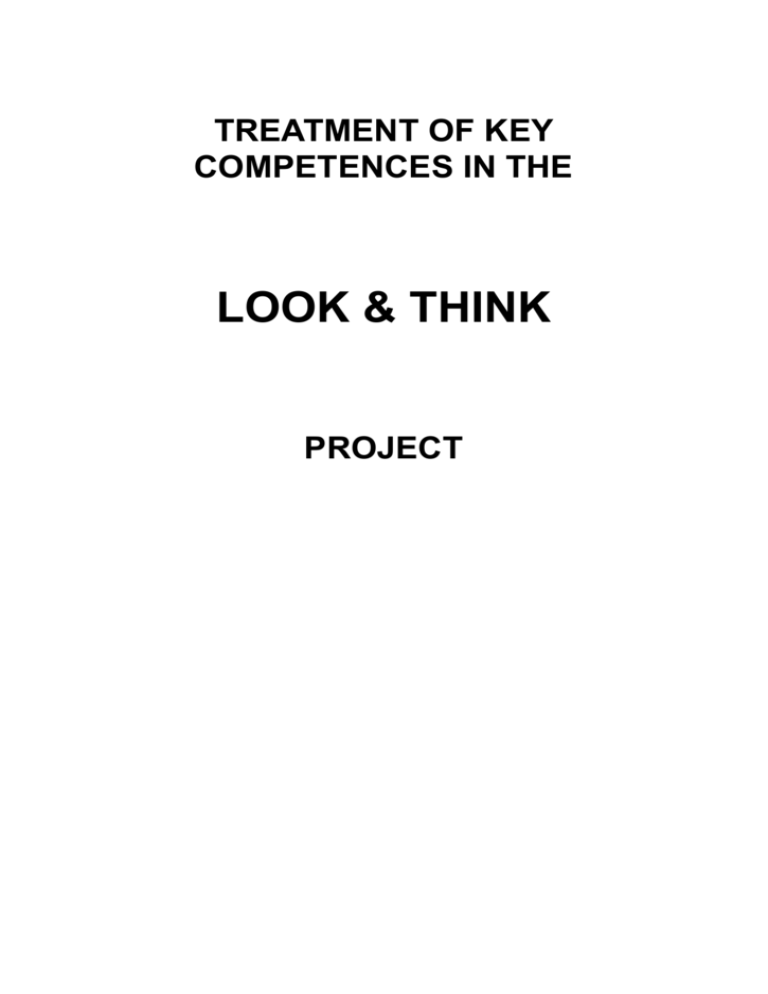
TREATMENT OF KEY COMPETENCES IN THE LOOK & THINK PROJECT Treatment of the key competences in the Look & Think project Article 6 of the Organic Law on Education (LOE) defines the curriculum as a “set of objectives, key (or basic) competences, contents, teaching methods and evaluation criteria for each one of the learning areas.” There are many definitions of this concept (publicly known in our country mainly as from the years 2000, 2003, 2006 and 2009 PISA Reports), but all emphasize the same points: in face of an education model focused on the acquisition of more or less theoretical or conceptual principles often disconnected from one another; the educational process based on key competences focuses mainly on the acquisition of essential knowledge that is practical, functional, transferable and comprehensive, knowledge that pupils are to put into practice. In short, a competence is the capacity to put into practice the integration of knowledge, skills and attitudes in order to solve problems and face situations in a variety of contexts. A graphical and concise definition of key competences describes them as acquired knowledge put into practice — knowledge in action —, that is to say, the mobilization of knowledge and skills in a specific situation (a real-life situation that differs from that in which the knowledge was acquired), the activation of resources or knowledge the student has (although they may think they do not have it because they have forgotten it). In any case, once teachers grow familiar with the concept and analyze specific examples, they will realize that part of their teaching activity and the evaluation models they apply are not that far from the methodological conception that underlies the key competences. Having said this, key competences have become one of the main guiding elements of the curriculum as a whole and consequently, of the teaching-learning process, especially when as in the case of one of the courses of this level (4th year Primary) pupils have to participate in what is known as the diagnostic evaluation, in which they will have to prove the acquisition of certain competences (or, at least, that they are on the road to achieving those that will gradually be established in the course at hand). In this sense, and on account of it all, key competences are present throughout the whole teaching-learning process and must be reflected in all the elements that shape it, since their incorporation in the curriculum has several aims: 1º. To integrate different types of learning: formal learning (corresponding to each area), non-formal learning (complementary and extra-curricular activities, center organization, etc.) and informal learning (generally the result of daily experiences and activities). 2º. To enable pupils to integrate their learning from different areas, relating it with diverse types of contents and using it efficiently in various situations and contexts; what is known as "knowledge in action" (What I know how to do with what I know) 3º. To be a guideline for teaching and decisions related with the teaching-learning process, identifying the essential content and evaluation criteria for pupils' education. The eight basic competences established by our education system and incorporated to the curriculum (with slight changes in the way they are called in some Autonomies such as Andalucía, for example) are : Linguistic competence. Mathematics competence. Awareness and interaction with the physical world competence. Information processing and digital competence. Social and civic competence. Cultural and artistic competence. Learning to learn competence. Autonomy and personal initiative competence. Emotional competence [only in Castilla-La Mancha]. But what do we understand by each of these competences? In short, and including the most significant points established in the Primary school curriculum, each of the competences contributes to the personal and intellectual development of the pupil – that is to say, it enables comprehensive education – and needs to be specified in each area, (not all subjects contribute in the same way to the achievement of the different competences): LINGUISTIC COMPETENCE Involves the use of language as a tool to enable oral and written communication as well as to learn and self-regulate thoughts, emotions and behaviours, also contributing, consequently, to the creation of a positive personal image, fostering constructive relations with others and with the environment. Learning to communicate is, therefore, what enables us to establish links with other people, to bring us closer to other cultures that take on significance and awaken our affection through a better knowledge of them. In all, the development of this competence is paramount to learn how to solve conflicts and to co-exist, and its acquisition implies proficiency in oral and written language in various contexts and the functional use, of, at least, one foreign language. MATHEMATICAL COMPETENCE This competence entails, above all, the skill to use numbers and basic operations, symbols and forms of expression and mathematical reasoning to produce and interpret information, to learn more about quantitative and spacial aspects of reality and to solve problems related with every day life and work. Its acquisition implies, in short, the application of skills and attitudes that enable mathematical reasoning, the understanding of mathematical argumentation, the expression and communication in mathematical language and the integration of mathematical learning with other areas of learning. COMPETENCE IN AWARENESS OF AND INTERACTION WITH THE PHYSICAL WORLD It is the ability to interact with the physical world both in its natural aspects and those generated by human action in such a way as to improve the understanding of events, the prediction of consequences and activities aimed at improving and preserving conditions of their own life, that of others and that of the rest of live species. In short, it implies the acquisition of scientific-rational thought to interpret information and make autonomous decisions using personal initiative and ethical values when making personal and social decisions. INFORMATION PROCESSING AND DIGITAL COMPETENCE This competence is based on the skills to search for, obtain, process and communicate information and to transform it into knowledge. It includes aspects that range from the access and selection of information to its use and transmission in different formats, including the use of information technology and communication as an essential element to be informed and communicate. Its acquisition implies being able to cope at least with the use of technological resources for efficient problem-solving and to be critical and reflexive when evaluating the information available. SOCIAL AND CIVIC COMPETENCE This competence makes it possible to live in society, to understand the social reality of the world we live in and to practise democratic citizenship in a growingly plural society. It incorporates individual behaviour patterns that enable people to coexist in society, relate with others, cooperate, commit and face conflicts; its acquisition entails being able to put oneself in another's position, to accept differences, to be tolerant and to respect values, beliefs, cultures and the personal and collective history of others. In short, it implies understanding the social reality we live in, being capable of facing up to conflict with ethical values and exercising citizens' rights and duties with a supportive and responsible attitude. CULTURAL AND ARTISTIC COMPETENCE This competence implies the awareness, appreciation, understanding and critical evaluation of the different cultural and artistic expressions, using them as a source of personal enjoyment and enrichment and considering them as part of people's cultural heritage. Finally, to appreciate and enjoy art and cultural expressions, it develops the skills that allow for an open and receptive attitude in face of a plural artistic reality, preserving the common cultural heritage and fostering our own creative capacity. LEARNING TO LEARN COMPETENCE This competence develops the skills needed, on one hand, to begin learning, and on the other, to be able to continue learning in autonomous manner, and enables the capacity of looking for answers that satisfy the demands of rational thinking. Likewise, it implies admitting a diversity of possible answers to a same problem and finding the motivation to look for them as from various methodological focuses. In short, managing their own capacities from the viewpoint of the search for efficiency and the use of intellectual resources and techniques. AUTONOMY AND PERSONAL INITIATIVE COMPETENCE This competence is related with the possibility of choice using their own judgment and undertaking the necessary actions to develop the chosen option and making themselves responsible for it, both in the personal sphere and in social and work settings. It implies being creative, innovative, responsible and critical in the development of individual or collective projects. EMOTIONAL COMPETENCE [ONLY IN CASTILLA-LA MANCHA] This competence is achieved when the pupil is able to carry out any activity assuming challenges in a responsible manner, establishing positive relations with others and getting to know themselves better. Its acquisition entails the development and promotion of personal self-esteem, feeling confident about themselves and their possibilities. In each area of the curriculum and to fully achieve the didactic utility of this curricular element known as the competences, we have subdivided them into what we call sub-competences, in favour of greater accuracy linked to the most specific aspects of the curriculum, especially to the activities and evaluation criteria, in such a way as to be easily identified by teachers. As a publisher of text books, our obligation is to contemplate the inclusion of basic competences – and their corresponding sub-competences in the different moments of the teaching-learning process, as illustrated, for example in the Students' Book, in the Teachers' Resources and in the Programmes. THE LOOK AND THINK PROJECT In each didactic unit of the Students' Book of the Look and Think project, the areas of Social and Natural Sciences and Artistic Education (Arts and crafts) include, to a lesser or greater extent, an implicit development of all the basic competences. In the Teacher's Book of Social and Natural Sciences and in every unit, the first page displays the classic programme model (objectives, contents and evaluation criteria). In the second page, under the title “competences”, there is a chart listing each one of the basic competences and sub-competences worked on in the unit and their relation with the evaluation criteria (we should keep in mind that competences are to be evaluated just like the contents) and the different activities (learning, evaluation...) With this list of sub-competences, we are indicating precisely how each area contributes to the acquisition of the corresponding basic competences: The Teacher's Book of Social and Natural Sciences also includes information on the general features of basic competences, such as the definition of the most significant learning areas included in each one of them as well as information about how the area contributes to their development. In addition, the Programmes of the Look and Think Project that are available on our website offer other aspects with proposals for more intensive work with key competences that resulted from the analysis we carried out of teachers' needs: Chart with the itemization of each key competence in sub-competences (identifiable learning and evaluation elements) and their presence in the different units of the Student's Book that help to identify each one of the competences worked on in the area and the smaller or bigger connection each subject has with one or several of the basic competences. Chart-register of the different key competences and sub-competences worked on in the area and course for the teacher to indicate the level of achievement in each one of them in the three evaluations throughout the course, as well as in the final ordinary and extraordinary exams. And finally, the table in which each of the basic competences and sub-competences of each didactic unit relate with the evaluation criteria of the unit and the different activities in the Student's Book (learning activities, evaluation activities...), thanks to which the teacher can easily identify the learning related with each sub-competence they are working on and evaluating when developing contents and when the pupils perform different and varied activities (according to educational aims, according to type ...).


